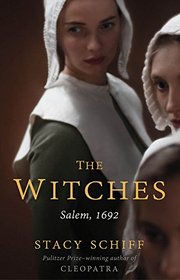Helpful Score: 2
If there's one historical event that the citizens of the United States had better never forget, it's the 1692 Salem Witch Craze, and historian Stacy Schiff's newest work could have gone a long way towards re-establishing the tragedies and injustices of the Witch Trials in the public consciousness--if the public could read it. In spite of all the laudatory blurbs provided to Amazon by the work's publisher, twice the number of Amazon Customer reviewers give it one or two stars than give it five. Three- and four-star reviews are in shortest supply. Sadly, there's a reason for this. "The Witches: Salem, 1692" is probably one of the most disorganized contemporary historical works that I've seen. The author begins by a caustic dismissal of perhaps the best known popular history of the Witch hysteria, Marion Starkey's 1949 "The Devil in Massachusetts", and undoubtedly the best known fictional portrayal, Arthur Miller's "The Crucible": "The Holocaust sent Marion Starkey toward Salem witchcraft in 1949. She produced the volume that would inspire Arthur Miller to write 'The Crucible' at the outset of the McCarthy crisis. Along with Nathaniel Hawthorne, Miller has largely made off with the story (p. 11)."
That sounds an awful lot like sour grapes, but to be fair, Stacy Schiff may have one legitimate gripe. She argues that most recent historians before her, including Starkey, have utilized sources that have been traditionally viewed as primary, but which are actually secondary, to begin the witchcraft story--namely, the monographs the ministers Increase and Cotton Mather penned one to five years after the craze had subsided. Only from the Mather writings, she contends, do we get the idea that the girls of Salem Village were introduced to witchcraft by elementary voudoun and fortune telling practiced by the Parris family's West Indian slave, Tituba, and Schiff theorizes that this was a "must-have-been" hypothesis supplied by the Mathers rather than an "actually-was" fact that could be gleaned from court documents or other contemporary records. For all that, though, Schiff chooses to prove her point by an eye-crossing myriad of dry, repetitive, poorly-arranged data that goes in, around, up, down, across, and through the chronological line to suggest that not only interpersonal community tensions but a confusing Gordian knot of other contributory factors, including even the political attitudes of a cabal of ministers who had worked together to oust the previous governor of the Massachusetts Bay Colony, Edward Andros, and establish the new one, William Phips, all had their part in the great witch scare.
I note with dismay how many other reviewers remark that they gave up trying to read the book, or simply started skimming, after so many pages along, because finally, on pp. 386-398, Schiff offers her own thoughts on the phenomenon's causes: hysteria, as defined first by Jean-Martin Charcot and later Sigmund Freud. And, by the anthropomorphic, schizophrenic-as-the-humans-who-thought-it-up God that the Puritans worshiped, she stands a danged good chance of being right. But if Schiff had only stated her thesis at her work's beginning and built her historical case around it in an orderly and logical manner, much as Marion Starkey had done with her own thoughts in 1949 however much they may have been influenced by Cotton and Increase Mather's after-the-fact hypotheses, Schiff could have produced a much more readable and compelling volume
That sounds an awful lot like sour grapes, but to be fair, Stacy Schiff may have one legitimate gripe. She argues that most recent historians before her, including Starkey, have utilized sources that have been traditionally viewed as primary, but which are actually secondary, to begin the witchcraft story--namely, the monographs the ministers Increase and Cotton Mather penned one to five years after the craze had subsided. Only from the Mather writings, she contends, do we get the idea that the girls of Salem Village were introduced to witchcraft by elementary voudoun and fortune telling practiced by the Parris family's West Indian slave, Tituba, and Schiff theorizes that this was a "must-have-been" hypothesis supplied by the Mathers rather than an "actually-was" fact that could be gleaned from court documents or other contemporary records. For all that, though, Schiff chooses to prove her point by an eye-crossing myriad of dry, repetitive, poorly-arranged data that goes in, around, up, down, across, and through the chronological line to suggest that not only interpersonal community tensions but a confusing Gordian knot of other contributory factors, including even the political attitudes of a cabal of ministers who had worked together to oust the previous governor of the Massachusetts Bay Colony, Edward Andros, and establish the new one, William Phips, all had their part in the great witch scare.
I note with dismay how many other reviewers remark that they gave up trying to read the book, or simply started skimming, after so many pages along, because finally, on pp. 386-398, Schiff offers her own thoughts on the phenomenon's causes: hysteria, as defined first by Jean-Martin Charcot and later Sigmund Freud. And, by the anthropomorphic, schizophrenic-as-the-humans-who-thought-it-up God that the Puritans worshiped, she stands a danged good chance of being right. But if Schiff had only stated her thesis at her work's beginning and built her historical case around it in an orderly and logical manner, much as Marion Starkey had done with her own thoughts in 1949 however much they may have been influenced by Cotton and Increase Mather's after-the-fact hypotheses, Schiff could have produced a much more readable and compelling volume




